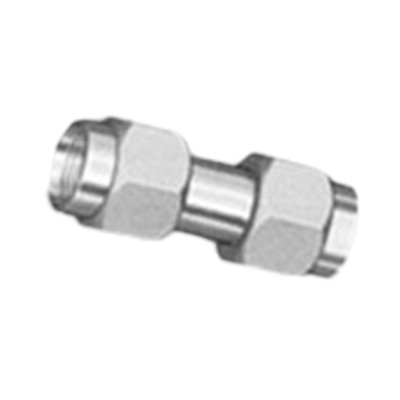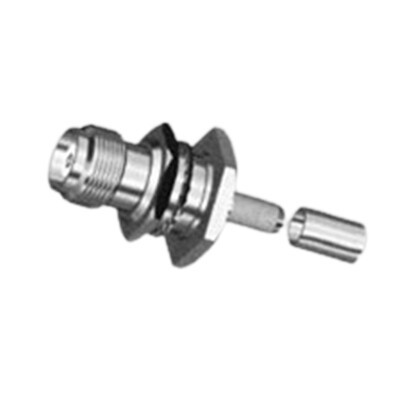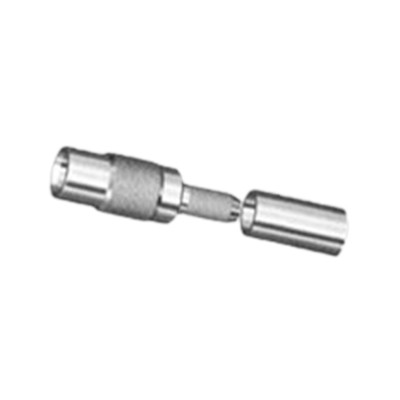RF connectors are the backbone of high-frequency signal transmission systems. Whether for telecommunications, aerospace, medical devices, or consumer electronics, choosing the right RF connector is critical for signal integrity, reliability, and long-term system performance. With numerous options available, it can be daunting to determine the best connector for your needs. This guide outlines 10 key factors to help you make an informed decision.
1. Frequency Range
The frequency range of your system is the first and most important factor to consider. Different types of rf connectors are designed to operate within specific frequency bands.
- Low Frequency (< 1 GHz): Connectors like BNC are suitable for applications like video or instrumentation.
- High Frequency (> 1 GHz): For high-speed data and communication, use connectors like SMA, N-type, or 2.92mm.
Ensure the connector can handle the frequency without introducing significant signal loss or degradation.
Double SMA Male Coaxial Connector XMR-SMA3080
2. Impedance
Impedance is a measure of resistance in an electrical circuit. RF connectors commonly come in two standard impedance values:
- 50 Ohms: Used in RF applications like wireless communication and radar systems.
- 75 Ohms: Ideal for video and broadband signal transmissions.
Using the wrong impedance can lead to signal reflections and loss, negatively affecting system performance.
3. Power Handling Capability
The power levels in your application determine the type of RF connector required. Overloading a connector can cause overheating and signal distortion.
- Low Power (<10W): Compact connectors like SMA or MMCX are ideal.
- High Power (>100W): Rugged connectors like N-type or 7/16 DIN are designed for high-power applications.
Check the manufacturer's specifications to ensure the connector meets your power requirements.
4. Connector Interface Type
The interface type determines how the connector attaches to cables and devices. Popular options include:
- BNC: Quick-connect functionality, ideal for test and measurement.
- SMA: Compact and supports high frequencies, used in telecommunications.
- TNC: Threaded for vibration resistance, suitable for aerospace and military applications.
Choose an interface that fits your application's physical and mechanical needs.
TNC Female Bulkhead RF Coaxial Connector for SYV-50-3 Cable XMR-TNC5110
5. Environmental Suitability
The operating environment significantly impacts connector choice. Factors to consider include:
- Temperature Resistance: For high-temperature environments, use connectors with PTFE insulation.
- Waterproofing: For outdoor or marine applications, opt for IP-rated connectors like N-type.
- Corrosion Resistance: Stainless steel or gold-plated connectors are ideal for corrosive environments.
Matching the connector to environmental conditions ensures reliability and durability.
6. Durability and Lifecycle
Durability is essential, especially in applications with frequent connections and disconnections. Look for:
- Mating Cycles: High-quality connectors support thousands of connections without degradation.
- Material Quality: Gold-plated or nickel-plated contacts resist wear and ensure longevity.
If your application involves mobile or portable equipment, prioritize durability.
7. Size and Weight
Compact devices require miniaturized RF connectors, but these must still maintain performance.
- Miniature Connectors: MCX, MMCX, or U.FL are perfect for devices with tight space constraints.
- Larger Connectors: Use connectors like N-type or 7/16 DIN when space is not a concern, especially in high-power systems.
Ensure the connector size complements the overall system design.
MCX Jack Crimp Coaxial Connector for SFF-50-1.5-1 Cable XMR-MCX1080
8. Insertion Loss and Return Loss
Insertion loss and return loss are critical performance metrics for RF connectors:
- Insertion Loss: Measures the signal loss as it passes through the connector. Lower values indicate better performance.
- Return Loss: Indicates how much signal reflects back due to impedance mismatch. Higher values are preferable.
Review the manufacturer's datasheets to select connectors with optimal performance metrics.
9. Ease of Installation and Maintenance
Some RF connectors are easier to install than others, depending on their design and the tools required.
- Quick-Lock Mechanisms: BNC connectors offer easy installation for frequent connections.
- Threaded Connectors: TNC or SMA connectors provide a secure fit but require more time for installation.
Consider whether your application requires frequent connector removal or permanent installations.
10. Cost and Availability
Balancing performance and budget is crucial when selecting RF connectors. High-quality connectors often come at a premium, but they ensure long-term reliability.
- Budget Constraints: Compare connectors from different brands for a cost-effective solution.
- Availability: Opt for connectors that are widely available to simplify future replacements or expansions.
Remember, investing in a durable, high-performance connector saves costs in the long run.
Why These Factors Matter
Selecting the right RF connector involves balancing technical requirements, environmental conditions, and cost considerations. By focusing on these 10 factors, you can ensure your choice aligns with your application's needs and delivers reliable performance.
Frequently Asked Questions (FAQs)
1. Can I use any RF connector for high-frequency applications?
No. RF connectors are designed for specific frequency ranges. Always verify the connector’s frequency rating.
2. How do I ensure proper installation of an RF connector?
Follow the manufacturer's guidelines and use the recommended tools to avoid damaging the connector or cable.
3. Are RF connectors waterproof?
Not all RF connectors are waterproof. For outdoor applications, choose weatherproof connectors like IP67-rated N-type.
4. What's the difference between SMA and TNC connectors?
SMA connectors are compact and ideal for high-frequency applications. TNC connectors are threaded and more vibration-resistant.
5. How do I know if my RF connector is durable?
Check the specifications for mating cycles and material quality. High-quality connectors typically last longer.
6. What happens if I use a mismatched impedance connector?
Impedance mismatches can cause signal reflections, resulting in poor performance and potential system damage.
Conclusion
Choosing the right RF connector is essential for ensuring optimal performance, reliability, and durability in high-frequency systems. By considering factors like frequency, power handling, environmental conditions, and cost, you can make an informed decision tailored to your specific needs. Invest in the right connector today to avoid performance issues tomorrow!
Related Articles
- A Comprehensive Guide to Coaxial RF Connectors2025-01-08
- Custom Antenna Design for High-Performance Wireless Systems2024-12-24
- The Different Types and Uses of RF Cable Assemblies2024-10-15
- Understanding RFID Antenna and VHF/UHF Antenna: Functions, Types, and Benefits2024-12-17
- Choosing the Best LoRa Antenna for Your IoT Applications2024-12-11
Contact us with the RF and Microwave coaxial connectors, RF cable assemblies and Antennas.
Get A Quote

XIAOMA is a supplier specializing in the R&D and manufacturing of RF CONNECTORS,CABLE ASSEMBLY AND ANTENNAS products. It also provides one-stop radio frequency solutions for electronic equipment. XIAOMA Technology's products are widely used in consumer electronics, communication equipment and infrastructure, mobile terminals and automotive electronics.
Contact Info
Contact Person : Rick, Haifa
Wechat / WhatsApp: + 86 18651023520
Follow
Share
Download after filling out the form


